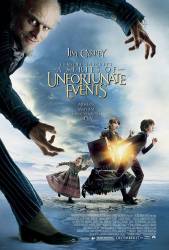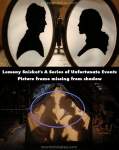Factual error: Before the Leeches attack the boat, Aunt Josephine throws out her banana peel. After she is abandoned by Olaf, the peel finally floats to the surface. A banana peel wouldn't even sink that low especially at the angle Aunt Jo threw it at. (01:10:05)
Factual error: When Klaus first finds the Eye, if you look closely at the light beam just as it exits the eye, it is curved like a vortex. Light cannot do this; it should have been straight more like a cone shape. (01:21:25)
Factual error: When Klaus burns the hole through the certificate, Count Olaf looks right through the hole into the magnified sunlight. His eye would be severely damaged if looking into sunlight through such a powerful magnifying object. (01:24:25)
Factual error: Olaf and Violet's marriage certificate bursts into flames after the light from the magnifying glass hits it. The papers would not burst into flames, despite the size of his magnifying glass, it should have just burned a hole. Obviously done to be dramatic. (01:24:25)
Factual error: When the children jump off the remains of Aunt Josephine's house, they jump further than they'd be able to. The slanting floor, at least, would reduce the distance, plus they didn't take enough of a run up to jump the gap.







Answer: A magnifying glass concentrates all the light that goes through it at its focal point, and it is this focal point that needs to be placed on the object which one wants to set on fire. The distance of the focal point to the lens depends on the magnifying glass characteristics, and it is more than likely that Count Olaf chose a glass where the focal point would be situated exactly "37 blocks" away from his house, that is, at the Baudelaire's mansion. When trying to set on fire an object much, much closer, the glass would concentrate much, much less energy, and would only be able to set on fire easily burnt objects, such as thin paper.
AnthonyA